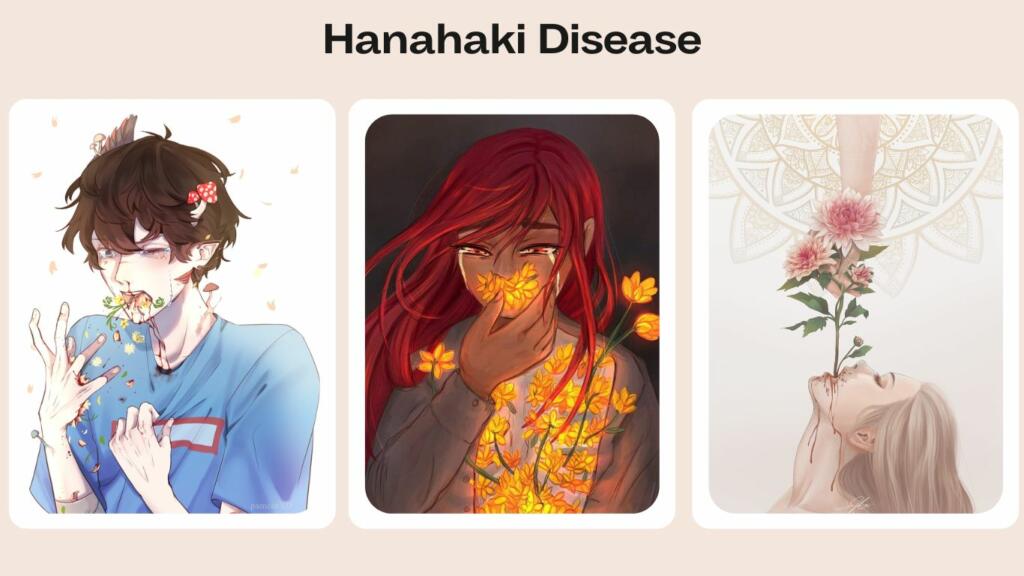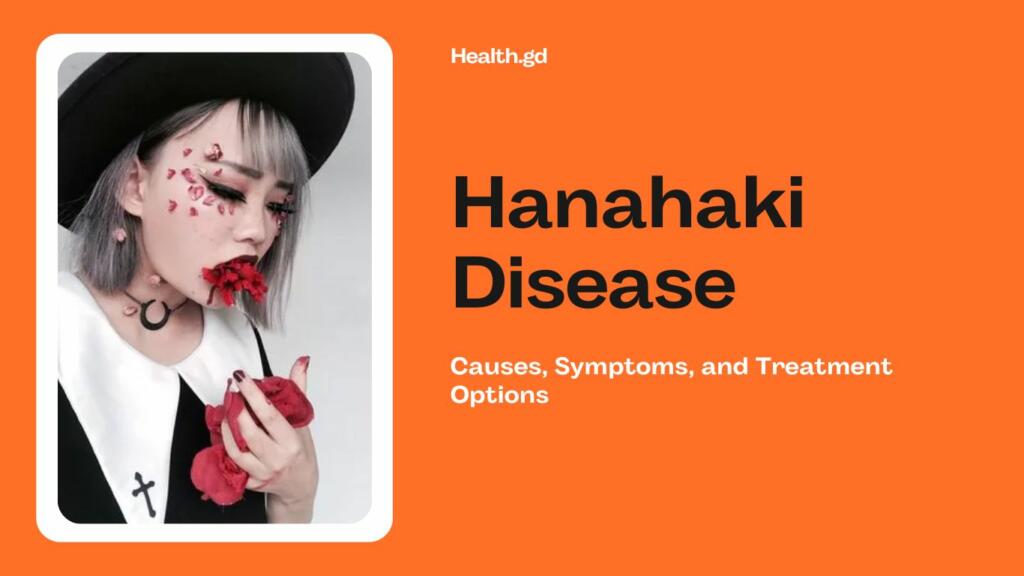How do you feel about coughing up flowers? And the next thing you know, you’re hacking out a daffodil.
Why are you spitting out flower petals? Well, because the person you love doesn’t love you back.
It’d be painful, no doubt, unpleasant. But could you call it beautiful in a tragic sense? Maybe even aesthetic? Realistically, probably not.
We’re talking crushed-up flower beds that are covered in blood and saliva.
But we’re looking at this through a fan fiction.

Today, we will discuss a widely known but often unheard-of trope that has appeared in mainstream media. It’s called ‘Hanahaki Disease,’ a syndrome that revolves around unrequited love. Now, let’s explore the origins and intricacies of Hanahaki Disease, and you might be more familiar with it than you think.
Let’s get into what Hanahaki is, where it came from, what causes it, what the symptoms are, what there is a cure, and why people enjoy reading about it.
What Exactly Is Hanahaki Disease?
Hanahaki Disease is a fictional ailment in which individuals experience unrequited love, causing physical manifestations such as vomiting flowers. The location of these flowers can vary, from growing in the stomach to the lungs or even the heart. Traditionally, it’s associated with the lungs. Alongside recognizable symptoms like chills and fever,
The main feature of this illness is the expulsion of flowers. However, it only occurs when love remains unreciprocated.
Suppose you’re madly in love with feelings beyond just attraction, or “I like this person.” We’re talking deep connection, care, and affection for someone very special to you, usually romantic,
When a character or person’s love isn’t mutual, Hanahaki Disease starts manifesting as burgeoning, sprouting flowers, typically growing in their lungs.
It’s not a virus or a bacterial infection.

One day, you wake up, and little plants are making their home in your body. The stronger the feelings or, the longer they’ve been going on, the more intense the bloom. And as the flowers keep growing in your lungs, they start taking up more and more space until you eventually start to suffocate and literally choke on them as they sprout up.
This is extremely painful. And because you need to breathe. Sometimes, if you want to go Hanahaki light, it just expels the petals and leaves. Or if you want to go hardcore, you can have someone coughing up whole plant systems, be it roots, stems, thorns, and all. Or you can go somewhere in between and have the flower and stem come out like an Albertson’s bouquet but covered in bodily fluids.
It can also vary due to severity. Someone who contracted Hanahaki a couple of days ago might be spitting out flower petals and leaves occasionally. In contrast, someone afflicted with the disease for months may be yakking the entire Home Depot nursery aisle every few hours. It can range from a minor annoyance, like a cold, to a debilitating, life-changing event.
Origination of Hanahaki Disease
The origin of Hanahaki is a mystery.
It’s been floating around in Eastern fandoms for decades with a lot of variation, ranging from symbolic to literal. But it became popularized and more well-known in fandom through the Shoujo manga “Hanahaki Otome,” published in 2007.
In which is about a girl who, after suffering from unrequited love, starts coughing, spitting, and throwing up flowers that grow in her heart and lungs.
While Hanahaki Disease may not be the most prominent trope, it is certainly not uncommon. Surprisingly, many people have never heard of it, especially in the West, as it originates from the East.
However, with the growing popularity of Eastern fandoms in different regions, this trope has started to bridge the gap and become more prevalent in the Western world.
It has even been featured in Western mainstream media, often taking on a horror trope twist, where flowers bursting forth from a person’s mouth symbolize a manifestation of combustion and decay. In these cases, it’s less about a doomed romance.
So, how did this trope come into existence? The term is of Japanese origin, combining ‘Hana’ meaning ‘flower’ and ‘Hakimasu’ meaning ‘to vomit.’ It was predominantly used about BL pairings or yaoi in Japan, although genre terminology and usage vary across locations.
The exact origins of the trope still need to be determined. Still, it gained popularity in the manga ‘Hana ha Kyoto May’ by Rokumon Sekka, where the symptoms were described as blooming flowers in the heart and lungs, followed by their expulsion in 2009.
How to Cure Hanahaki Disease?
Now, let’s explore the cures and origins of Hanahaki Disease and its connections to angsty romance and symbolic elements.
To cure Hanahaki Disease, there are various remedies to consider.
1. Help with Feelings

The most hopeful outcome is for the person’s desired partner to reciprocate their feelings romantically. It’s important to note that close friendship alone usually only suffices if the trope is modified. The dreaded ‘friend zone’ is unlikely to provide a solution.
2. Surgery
Another option is the surgical removal of the infected flowers, but this may also result in the loss of the person’s feelings of love. Only some people choose this route, as it doesn’t align with the dramatic appeal that some associate with this trope. Unfortunately, in some cases, the sufferer may succumb to their illness and even die. As you can tell from these descriptions, this trope is deeply tied to the angsty nature of unrequited love.

It often serves as a means to explore the pain, frustration, and sometimes hopelessness experienced in one-sided affection. The flowers themselves hold symbolic meaning, as throughout history, flowers have conveyed various sentiments and emotions. They have even served as vehicles for coded messages. The specific flower involved can also carry significance within the work.
Where will you find Hanahaki Disease?
If you’re interested in exploring works that feature Hanahaki Disease, there are various mediums where you can find it. Thanks to tagging systems, it’s relatively easy to search for this trope on fan sites and discover a wide array of works.
You’ll come across fanfiction, fan art, fan videos, and even films that incorporate the theme of Hanahaki Disease. It’s worth mentioning that you can also use the tags to exclude this trope if it’s something you prefer to avoid.
While Hanahaki Disease can be found in any fandom, there are certain areas where it is more likely to occur. It is particularly common in band fandoms, especially K-pop groups like BTS. However, it is also associated with other bands such as Seventeen, EXO, or One Direction in the Western context. It is also more prevalent in anime-based fandoms than in Western animation or live-action ones. However, with the increasing crossover between different cultures and fandoms, Hanahaki Disease is becoming more common in Western media and other areas.
It has even appeared more frequently in fandoms such as Voltron or Supernatural.
For those intrigued by this trope, Hanahaki Disease offers an intriguing take on the age-old tale of unrequited love. It combines heart-wrenching angst, the sickness motif, and the potential for both tragic and happy endings within one accessible narrative device. If you are fond of exploring the depths of emotions, symbolism, and the clash between beauty and sorrow, Hanahaki Disease might be a trope worth exploring further.
Share your thought
Hanahaki is a popular trope because it taps into deep emotions and explores themes of unrequited love, sacrifice, and the pain of longing. It allows readers to empathize with the characters and experience the bittersweetness of love that has not returned. It can be cathartic and emotional, providing a sense of release and understanding for those who may have experienced similar feelings in their own lives. The tragedy and angst of Hanahaki can also create tension and drama in a story, keeping readers engaged and invested in the outcome. Hanahaki resonates with many people due to its exploration of complex emotions and its ability to evoke strong emotional responses.
Were you previously aware of Hanahaki Disease? If so, where did you first encounter it? Feel free to share your thoughts and experiences. Also, if you’re interested in delving deeper into tropes and their origins or have a favorite trope, don’t hesitate to let us know. We always appreciate your engagement and look forward to reading your responses.








